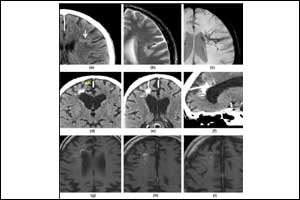- Home
- Editorial
- News
- Practice Guidelines
- Anesthesiology Guidelines
- Cancer Guidelines
- Cardiac Sciences Guidelines
- Critical Care Guidelines
- Dentistry Guidelines
- Dermatology Guidelines
- Diabetes and Endo Guidelines
- Diagnostics Guidelines
- ENT Guidelines
- Featured Practice Guidelines
- Gastroenterology Guidelines
- Geriatrics Guidelines
- Medicine Guidelines
- Nephrology Guidelines
- Neurosciences Guidelines
- Obs and Gynae Guidelines
- Ophthalmology Guidelines
- Orthopaedics Guidelines
- Paediatrics Guidelines
- Psychiatry Guidelines
- Pulmonology Guidelines
- Radiology Guidelines
- Surgery Guidelines
- Urology Guidelines
Some Neuroanatomical Variants usually misinterpreted radiologically

Misinterpretation of common anatomical variants can lead to misdiagnosis and unnecessary waste of time and resources. In an era of rapidly progressing technology and radiological studies moving to imaging at a molecular level, sometimes these common imaging features are still confused with pathologies.
It is therefore not surprising that an article entitled ‘’Normal neuroanatomical variants that may be misinterpreted as disease entities’’ has been one of the most popular articles downloaded on clinical radiology within past 90 days (Elsevier).While most can be differentiated on background knowledge of morphology and location, few are still challenging. The most important task is thus, to separate benign, incidental findings so as to prevent overzealous treatment. A brief mention of such mimics is provided in this review article.
| ANATOMICAL VARIANT | MAY MIMIC… | SOLUTION |
| Arachnoid granulations | Venous sinus thrombosis | Usually CSF signal, no blooming on SWI, CT venogram is confirmatory |
| Developmental sutures eg. metopic | Fractures | Knowledge of paediatric skull anatomy |
| Pneumatized anterior clinoid process | ICA aneurysm | CT bone window, angiography |
| Asymptomatic pineal cyst | Pineocytoma on NECT | Follow up |
| Physiologically enlarged pituitary | Macroadenoma | Correlation with age/sex/pregnancy & lactating status |
| Empty sella | Cystic lesion | Identification of infundibulum |
| Developmental venous anomalies | Arterio-venous malformatons | MRI with SWI, contrast- caput medusa head pattern |
| Capillary telengectasia- pons | Central pontinemyelinolysis, Pontine Glioma | Contrast MR- faint enhancement, SWI-hypo intense, DWI- no restriction |
| Hypoplasia of transverse sinus | Sinus thrombosis on MRV | NECT for small bony groove, routine CECT, MRI with SWI |
| Prominent Virchow Robin (VR) Spaces | Lacunar infarcts, Neuroglial cysts | Lacunar infarcts have typical morphology, typical location of VR spaces. |
| Fossa navicularis magna | Lesion in clivus | Bone window for erosion, intact clivus |
| Asymmetric, petrous fatty marrow | Cholesterol granuloma on T1 weighted MRI | Lack of mass effect, fat supressed images |
| Petromastoid/subarcuate canal | Fracture | Knowledge of course of canal |
For example when there is confusion in differentiating sinus thrombosis from developmental hypoplasia, the sigmoid and jugular groove in the base of the skull on CT can be looked at. The bony groove will be smaller in hypoplasia. Similarly, for detecting venous sinus thrombus, hyperdensity will usually be seen on CT with empty delta sign on CECT. More definite analysis can be only on contrast venography which can be further confirmed on DSA (with manometry) to evaluate true stenosis.
On MRI, plain T2 images may not show flow void due to slow blood flow. In such case DWI will be useful and SWI will show blooming in the thrombus. The acute thrombus may be missed as it will not be hyperintense on T1/T2 images.
Similar other examples which may mimic pathology-
- Pcom infundibulum being mistaken for an aneurysm.
- Hypoplastic ICA can be confused with a dissection or fibromuscular dysplasia.
- Agenesis of ICA may be confused with occlusion.
- CT- or MR-Perfusion asymmetry in the occipital lobes, in cases of unilateral fetal PCA. The contralateral side may show delayed perfusion because it is supplied by the posterior circulation.
- Relative hypoperfusion in the PICA territory in cases of vertebral artery hypoplasia
(Source: http://dx.doi.org/10.1594/ecr2016/C-0199)
Abbreviations:
MRI- Magnetic resonance imaging
NECT- Non enhanced Computed Tomography
CECT- Contrast-enhanced CT
SWI-Susceptibility weighted imaging
DWI- Diffusion-weighted imaging
CSF- Cerebrospinal fluid
ICA- Internal carotid artery
Source: S. Ramji, P. Touska, P. Rich, A.D. MacKinnon, Normal neuroanatomical variants that may be misinterpreted as disease entities, Clinical Radiology xxx (2017) 1-16
Further reading: Atlas of Normal Imaging Variations of the Brain, Skull, and Craniocervical Vasculature by McKinney, Alexander (Springer; 2017)
Dr. Niharika Prasad,
The author is MD (Radiodiagnosis) and is Senior Resident, Dept of Radiology in All India Institute of Medical Sciences, AIIMS Patna. She is a member Editorial Board, Radiology at Specialty Medical Dialogues.

Disclaimer: This site is primarily intended for healthcare professionals. Any content/information on this website does not replace the advice of medical and/or health professionals and should not be construed as medical/diagnostic advice/endorsement or prescription. Use of this site is subject to our terms of use, privacy policy, advertisement policy. © 2020 Minerva Medical Treatment Pvt Ltd